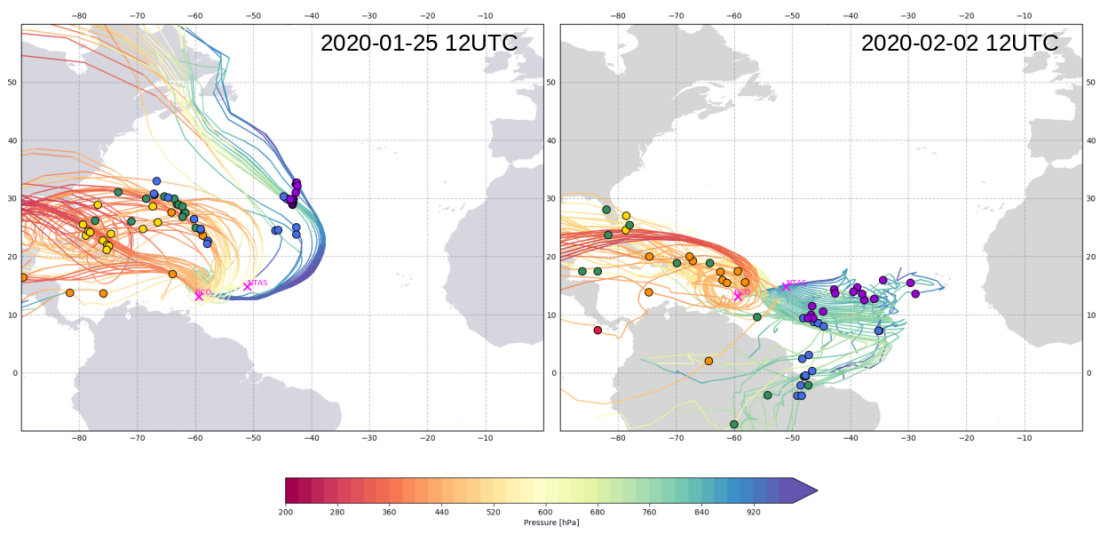Water vapour & isotopes
Modelling and Instrumentation
The atmospheric water cycle is a central component of the climate system. The transport of humidity from the regions of oceanic or continental surface evaporation redistributes latent energy and provides the necessary moisture input for cloud formation and precipitation. To study this atmospheric water vapor transport in detail, we use a Lagrangian approach. Atmospheric moisture sources and sinks are diagnosed from humidity changes along 3D trajectories calculated based on wind fields from different types of datasets (atmospheric reanalyses and analysis data). In this way, insights are obtained into the climatological moisture sources of water vapour and precipitation in different regions of the world.
Stratospheric water vapor has been identified as a strong driver of sea surface temperature (Solomon et al. 2010) enhancing the trend caused by the well mixed greenhouse gases alone by 30% during the years 1980 to 2000 and mitigating it by 25% from 2001 to 2009. Frost point hygrometers based on the chilled mirror principle have evolved as reference technology for balloon borne measurements of water vapour in the target region ranging from tropopause levels up to and above 25 km altitude. The ban of the tetrafluoromethane cryogen coolant – itself a strong greenhouse gas – by the Kigali Amendment of the Montreal Protocol challenges current and further application of this technique. The Peltier Cooled Frost-point Hygrometer (PCFH) is being developed as an alternative. It uses a Peltier element in conjunction with the ambient air flow to cool and control the mirror temperature to the frost point and thereby provides a direct measurement of the water vapour partial pressure. As component of the Swiss H2O Hub project founded by MeteoSwiss it is deployed and compared, during regular sounding campaigns, with the commercially available Cryogenic Frost-point Hygrometer (CFH), the newly developed tuneable diode laser instrument ALBATROSS (Empa Dübendorf), and well-established ground-based remote sensing instruments (RALMO lidar at MeteoSwiss Payerne and MIAWARA radiometer, University of Bern).
A complementary perspective on the atmospheric water cycle is obtained from the analysis of stable water isotopes (SWI). The isotopic composition of water vapor and precipitation is sensitive to, and can thus provide information on, specific processes in the water cycle, such as the conditions during the evaporation of water from the ocean or land surface, turbulent and convective mixing, cloud and precipitation formation, and below cloud microphysical interactions of falling hydrometeors with ambient water vapor. In our group, measurements of SWI in water vapor and precipitation with laser spectrometers on different platforms are combined with SWI modelling using models of varying complexity, including an isotope-enabled version of the limited-area weather prediction and climate model COSMO. Our research aims to identify relevant weather systems and related moist processes shaping the atmospheric water cycle and to understand the role of the water cycle for the atmospheric cycling of chemical compounds (in collaboration with the institute of biogeochemistry and pollutant dynamics).
The senior scientists working in this research area and their core themes are Iris Thurnherr (atmospheric water cycle in polar regions), Frank Wienhold (PCFH development) and Yann Poltera (analysis of water vapour balloon sounding data and PCFH deployments for Swiss H2O Hub).
Stable water isotopes as tracers of moist processes in shallow trade wind cumulus clouds

Leonie Villiger
Shallow cumulus clouds are the most frequently occurring cloud type in the atmosphere. Due to their high albedo, they strongly modulate Earth’s energy budget, particularly over the dark tropical oceans. However, our knowledge about their formation, organisation and interaction with the large-scale circulation is still fragmentary. This limited understanding is reflected in the inconsistency of modelled low-level cloud feedback to warming, a major source of uncertainty in climate projections.
To disentangle the different scales of interaction between low-level clouds and large-scale circulation, this PhD project proposes to use stable water isotopes in meteoric waters as tracers of moisture sources and sinks. During the campaign external pageEUREC4Acall_made in early 2020 on the Caribbean island Barbados, in situ aircraft and ground-based laser spectrometric isotope measurements of trade wind cumulus clouds were performed. As a complement to the measurements, an isotope-enabled numerical model (COSMOiso) is used to perform convection-resolving simulations. With this combination of measurements and numerical modelling, a cloud-scale water isotope characterisation of the environment, in which trade wind cumulus clouds form, is produced. Using the air-parcel trajectory analysis tool LAGRANTO, the measured and simulated isotope signals are related to different large-scale flow configurations, as well as to different mesoscale cloud organisation patterns.
Supervised by Franziska Aemisegger
